Affiliate disclosure: This post may contain affiliate links. Please see our Privacy Policy.
Usnea is an edible lichen, with potent medicinal properties. It grows all over the world, and it’s often easy to find and abundant.
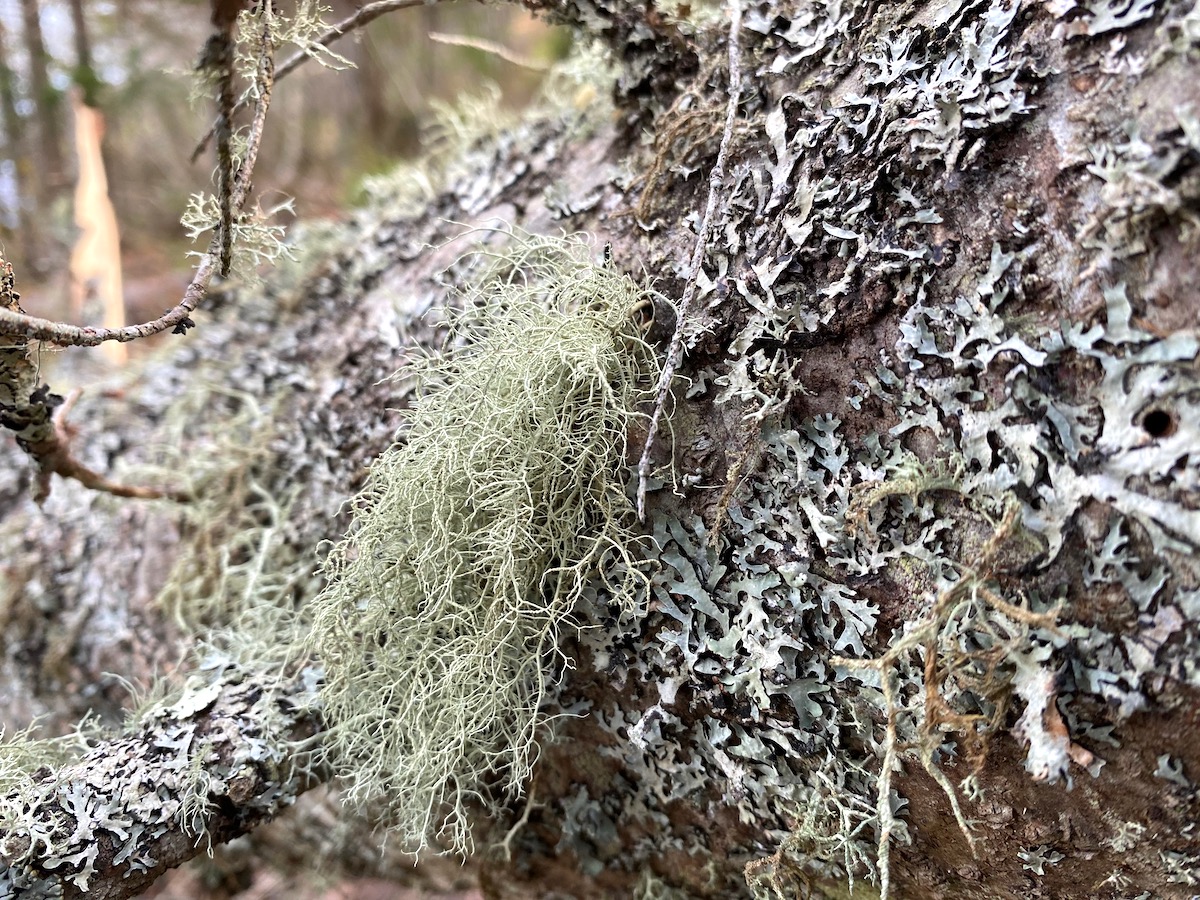
Often called “old man’s beard” or “the lungs of the forest,” usnea is a common edible and medicinal lichen that grows in forests around the world. Usnea has been used as a traditional antibiotic, both topically and internally, since pre-history.
It’s especially common in the Pacific Northwest, where it’s harvested commercially. Usnea is also common throughout Europe, where it was used to staunch bleeding and disinfect wounds on the battlefields in antiquity.
You’ll often see LARGE specimens hiking in alpine regions elsewhere, but it’s common in forests even at lower elevations. Take a good look at the branches of an apple tree in a PYO orchard and you might also find it there.
Usnea is everywhere!
It tends to grow most prolifically in places with good clean airflow, either at the top of trees or at the top of mountains. A stiff breeze (or a storm) will knock down patches, making it easy to harvest alongside trails after storms.
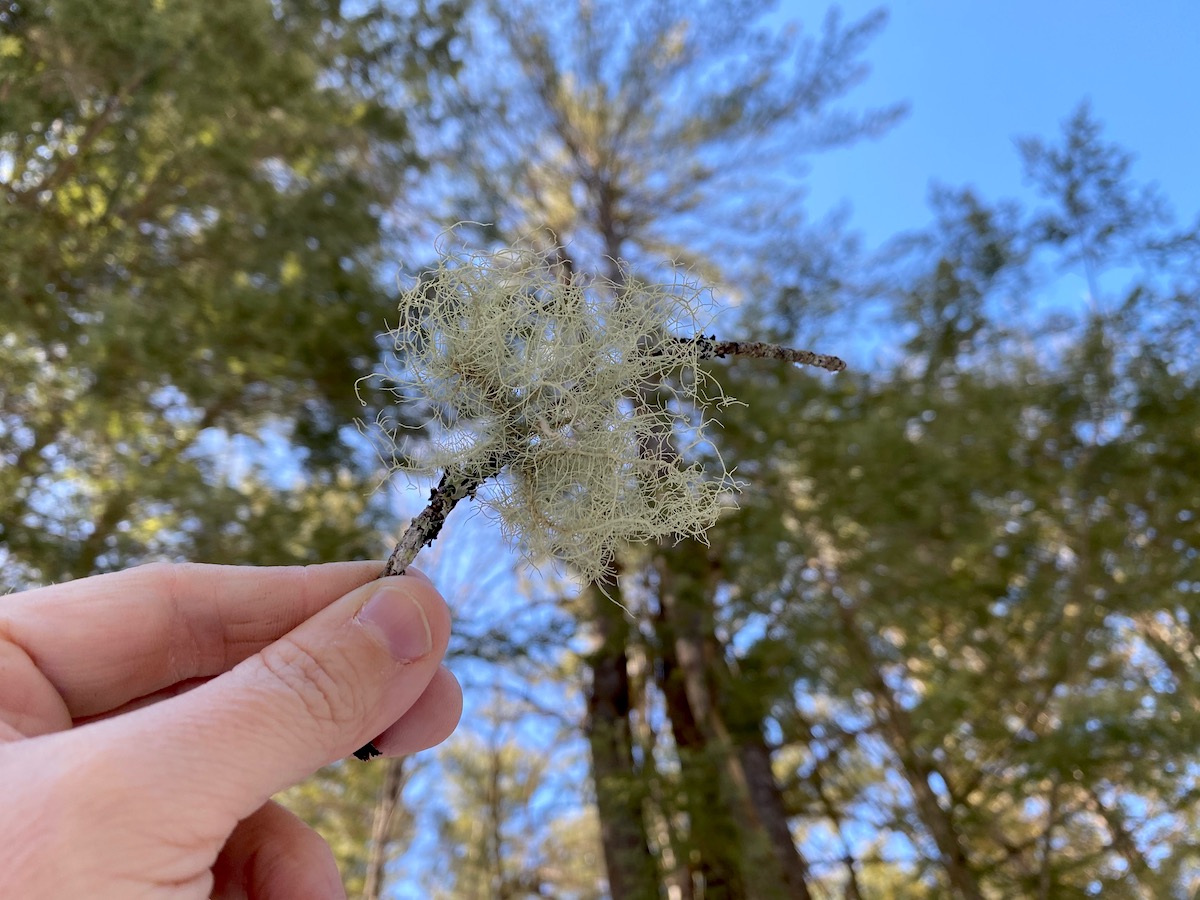
Usnea Medicinal Benefits
While it is “edible” most people don’t generally go around eating it. In large quantities, it can cause a bit of stomach upset, but that’s true of many foods. It’s not meant to be eaten as a meal but rather consumed in small amounts medicinally (or used topically).
(If you’re curious, it has a relatively neutral taste, with just a bit of citrus-like acidity and a very mild bitterness. I actually rather like it, and I think the tincture tastes a tiny bit like a good gin.)
Medicinally, usnea is best known for its antibiotic properties. There are only a few herbal antibiotics, so that makes it a valuable find.
Unlike some herbs which work systemically in the body, usnea needs to be in contact with the microbes to have an impact. That means it’s generally used topically for cuts and wounds, or for problems in the mouth, throat, or digestive tract.
The Boreal Herbal notes that “Usnea contains usnic acid that, in one form or another, has been used as a mild antibiotic for hundreds of years. It’s reported to have antiviral, antifungal, and antibacterial actions, and has even been used to kill Streptococcus and Staphylococcus bacteria.”
The Herbal Apothecary by JJ Pursell confirms those uses and adds that usnea is used to fight infections, especially fast-growing pathogens. “Usnea seems to differentiate good bacteria from bad in the body, sparing the good gut bugs we need to fight infections. It can also be used externally for outbreaks of staph, cellulitis, and for infected wounds.”
Historically, dried usnea was packed into wounds as a natural antibiotic wound dressing, but these days it’s more commonly applied as an infused oil or herbal tincture.
Further down in the digestive tract, usnea can also treat stomach, intestinal and urinary tract issues. The Backyard Herbal Apothecary discusses its uses against candida (yeast) infections, urinary tract infections, and potentially even E. coli and food-born illnesses.
Beyond its antibiotic uses, usnea is also used as an immune stimulant.
JJ Pursell also notes that it’s “safe to take with echinacea for a short period of time to boost the white blood cells and give the body a blast of immune support.”
Lastly, usnea was traditionally used to treat respiratory issues, ranging from cough to pseudomonas and tuberculosis. It’s also used for sinus infections.
Usnea Safety
While it’s generally regarded as safe, even for young children and the elderly, usnea still has a few things to keep in mind for herbal safety.
According to The Backyard Herbal Apothecary, “High concentrations of usnic acid may cause liver damage, but these concentrations cannot be achieved in the home using the whole herb and standard tincturing methods.”
Consuming lichen of any kind can also irritate the kidneys if consumed in large quantities over a long period of time.
Those issues mostly come up historically in times of famine, when the lichen was eaten in large quantities. It would also be relevant to keep in mind in a survival situation.
As with any herb, it’s always possible to have an allergic reaction. Some people react to usnea, topically and internally. Topical reactions can mean a localized rash, but it can be more harmful if taken internally.
Always be careful with new plants and herbs until you know you’re not sensitive to them.
Where to Find Usnea
Usnea is one of those things you can find everywhere…and nowhere at the same time. It can grow just about anywhere in the world, and it’s found all over Europe, Asia, and the US.
That said, it’s incredibly sensitive to air pollution, and there’s generally air pollution where large human populations congregate. Once in the woods, you’ll see it everywhere, and it’s especially common in pristine alpine locations.
Here in Vermont, you can find it just about anywhere trees grow. It’s commonly growing out of pine and ash in the woods, as well as both apple and plum.
It grows at the top of nearly every pine tree on our land, and it’s sprouting out of the sides of most of the trees in our orchard, both plum and apple.
If you’re out hiking, look for downed pine tops and you’ll find huge crops of usnea. Since it only really thrives up in the air on standing trees (dead or alive), it’s not long for this world once the tree falls to the ground.
Feel free to harvest it if you see it on a downed tree.
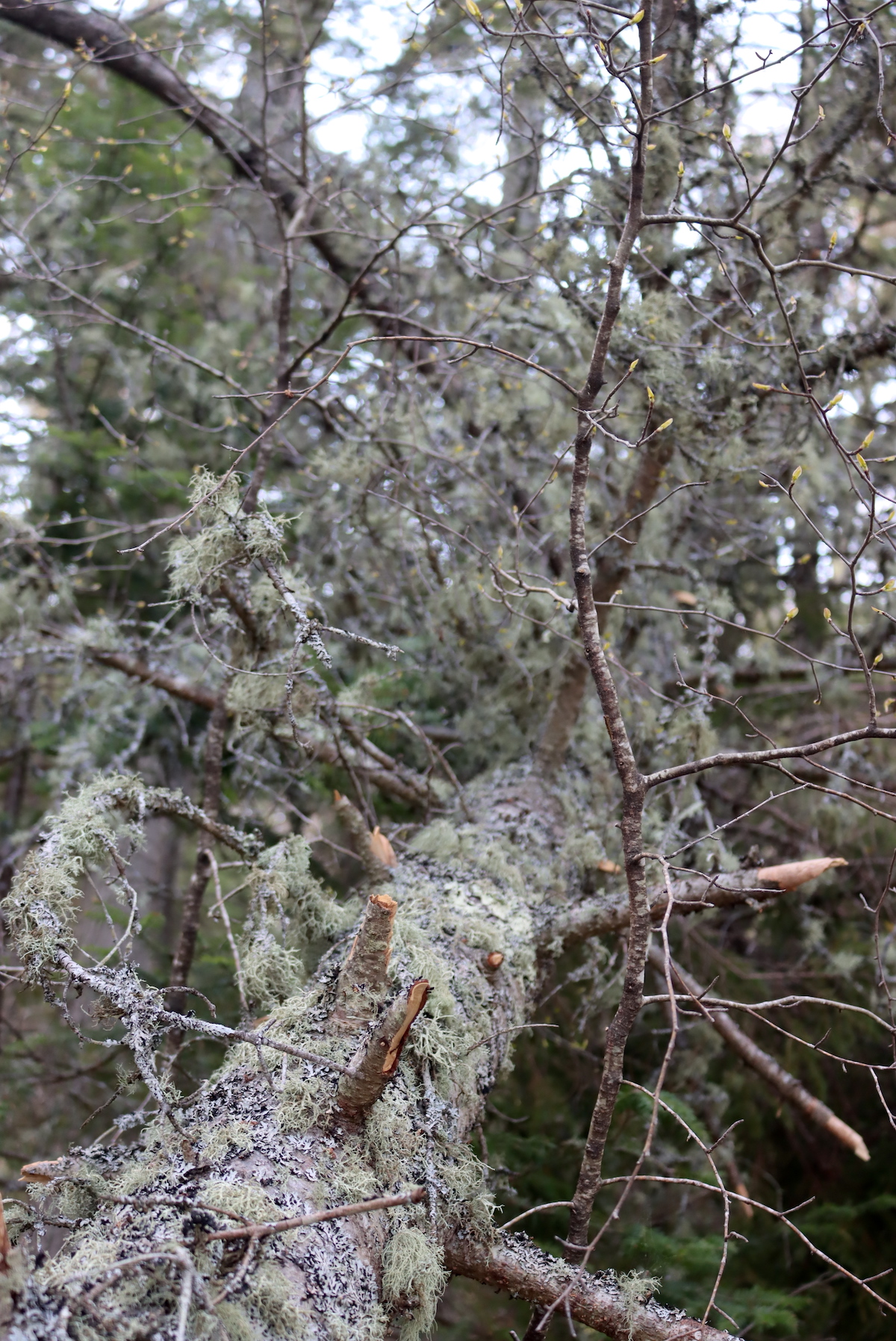
Identifying Usnea
There are a lot of different species of usnea, and its exact growth habit can vary considerably based on your region. Regardless of the actual species, the main identification characteristics are the same.
The key ID characteristics for Usnea make it easy to identify, as no other lichen has those same characteristics, but they’re common across all Usnea species.
Those include:
- Light green coloration
- Single Attachment Point to wood (dead or living)
- Round Growth (not flat)
- A flexible inner white core under the green outer sheath
Most people look for long, stringy lichen dangling from trees. That’s how it tends to look in alpine regions, and in the Pacific Northwest.
Here in the northeast, there’s a bushy variant of usnea that looks more like a toupee, of a fluffy patch of beard rather than a long stringy one. The long stringy nature of usnea is not universal, but the other ID characteristics are.

Start by looking for a light green colored lichen with round growth.
The round “stems” on the lichen are one of the main ID characteristics, as most lichen doesn’t have this tube-like growth pattern. Inside each round piece, there’s a white, string-like core which I’ll show you later.
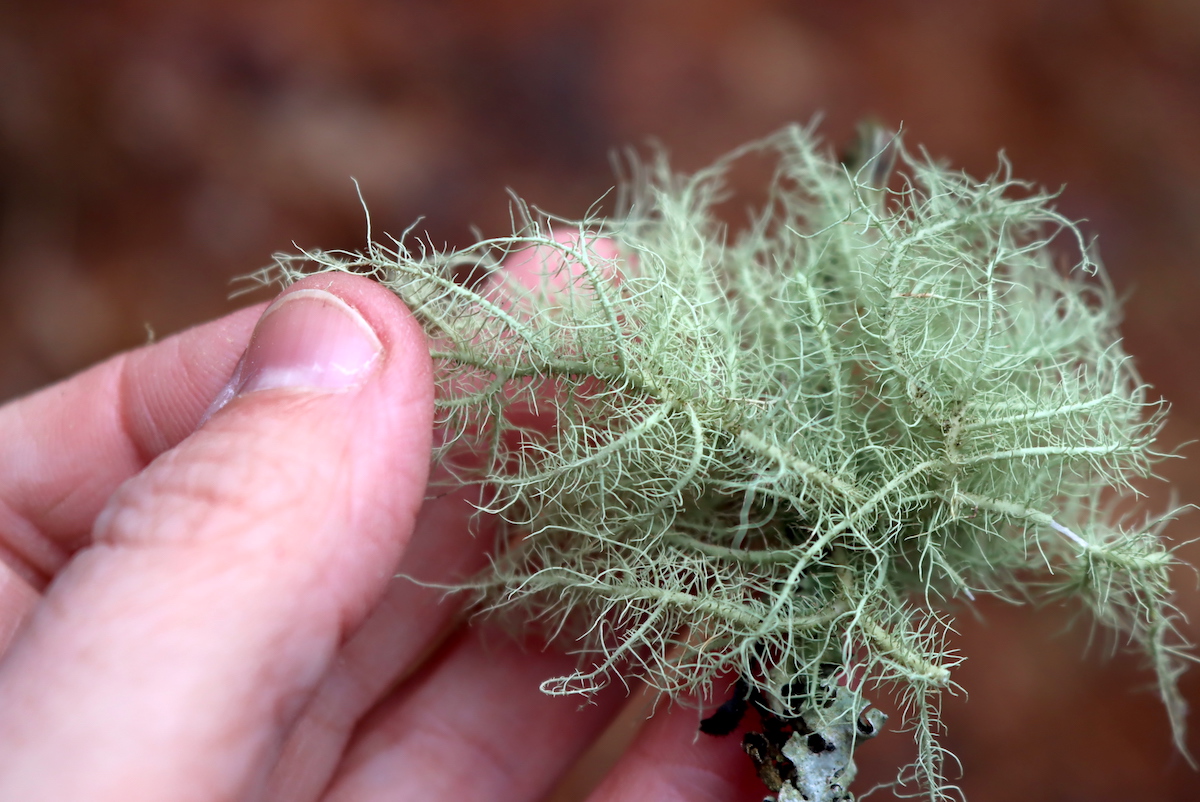
Once you’ve found a stringy specimen of light green lichen attached to wood, take a look at exactly how it’s attached.
It may be fluffy and tuft-like, or long and stringy, but either way, it’ll only be attached to the wood at a single attachment point.
Look closely at where it attaches to the branch or trunk, it should be a tiny single point.

Once you’ve ensured it has a round growth and a single attachment point, we’re on to the true test.
Use your fingernail to scrape off the outer sheath of the lichen. Inside you should find a flexible white core, that’s a bit like a string of elastic. It’s not quite as flexible as actual elastic, but it should stretch a bit if you pull on it.
Once usnea drys out a bit the cores get a bit brittle and may break easily, so the flexibility isn’t the ID characteristic. It’s just the core itself.
Usnea species are the only lichen to have an inner white core beneath the light green outer sheath. Once you’ve found this, you definitely have a usnea species.
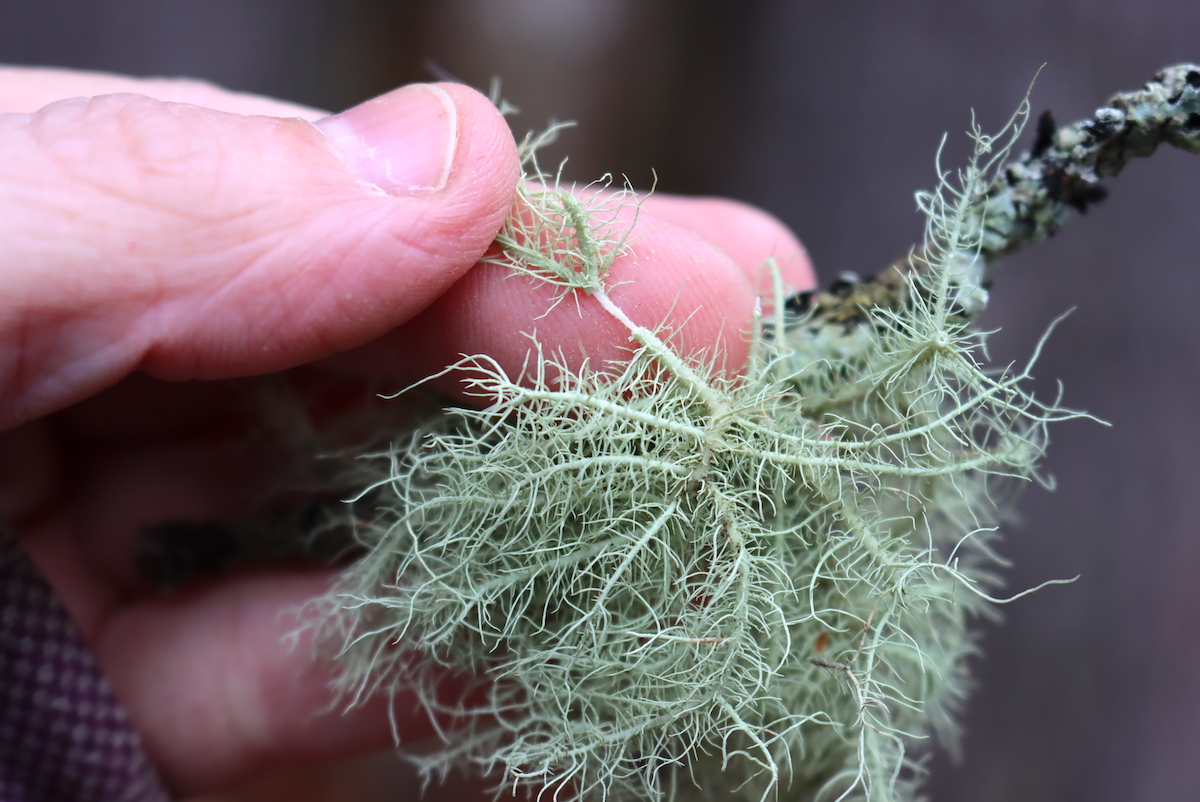
Usnea Look-Alike
There are a number of types of lichen that grow on trees just about everywhere in the world, and I’ll be honest, I definitely can’t identify most of them.
That’s ok, you don’t have to know every single type of lichen out there. Usnea has enough unique identifying characteristics that it’s really not necessary to know the others (unless you’re after them).
Locally, there’s a stringy lichen that has a similar growth habit to usnea, and we often find them growing right next to each other.
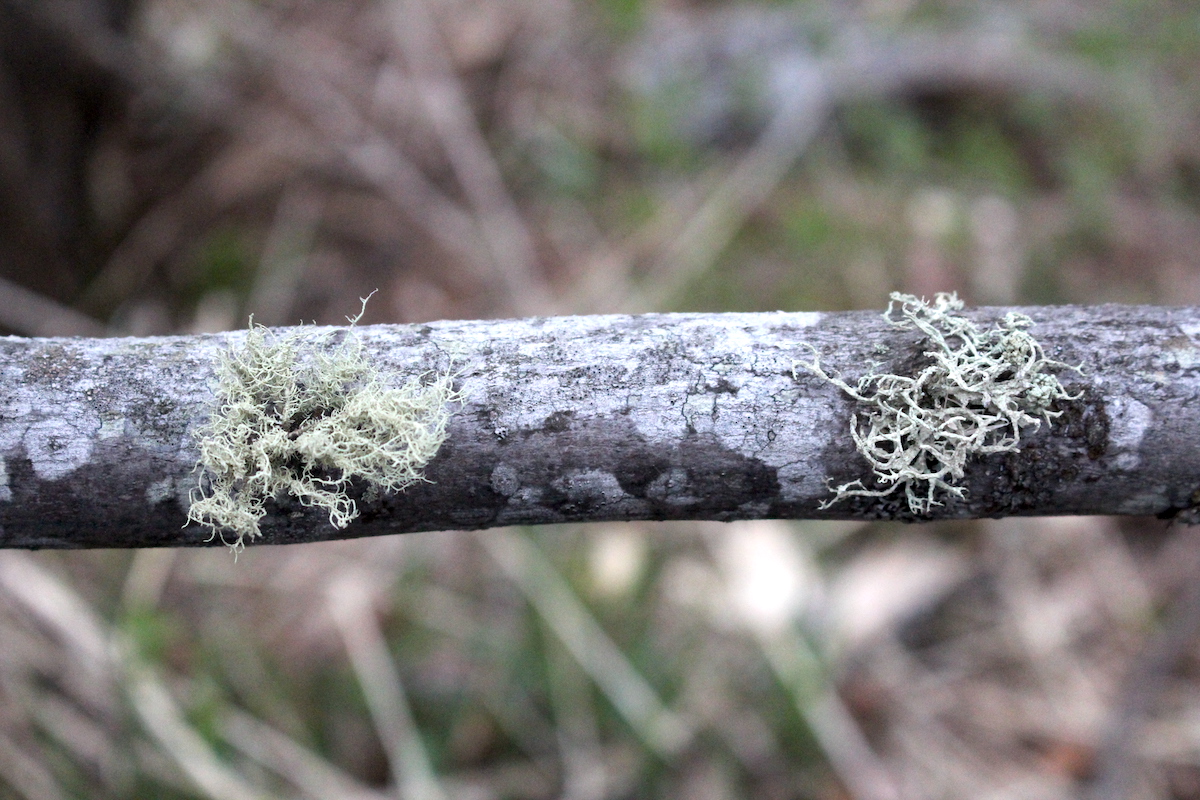
The usnea look alike we have here just looks like usnea from a distance, and once you get up close it’s easy to tell the difference.
Often the look-alike does have a single attachment point and a branching structure, along with light green color. It has some of the characteristics of usnea, but not all of them.
The look-alike does not have:
- Round growth, instead it’s flat and a bit curled
- An inner white core, instead it has no core
In your area, there will likely be some lichens and moss species that look similar to usnea, but none of them will have all of the key identifying characteristics. Especially the white core, which is unique to usnea species.
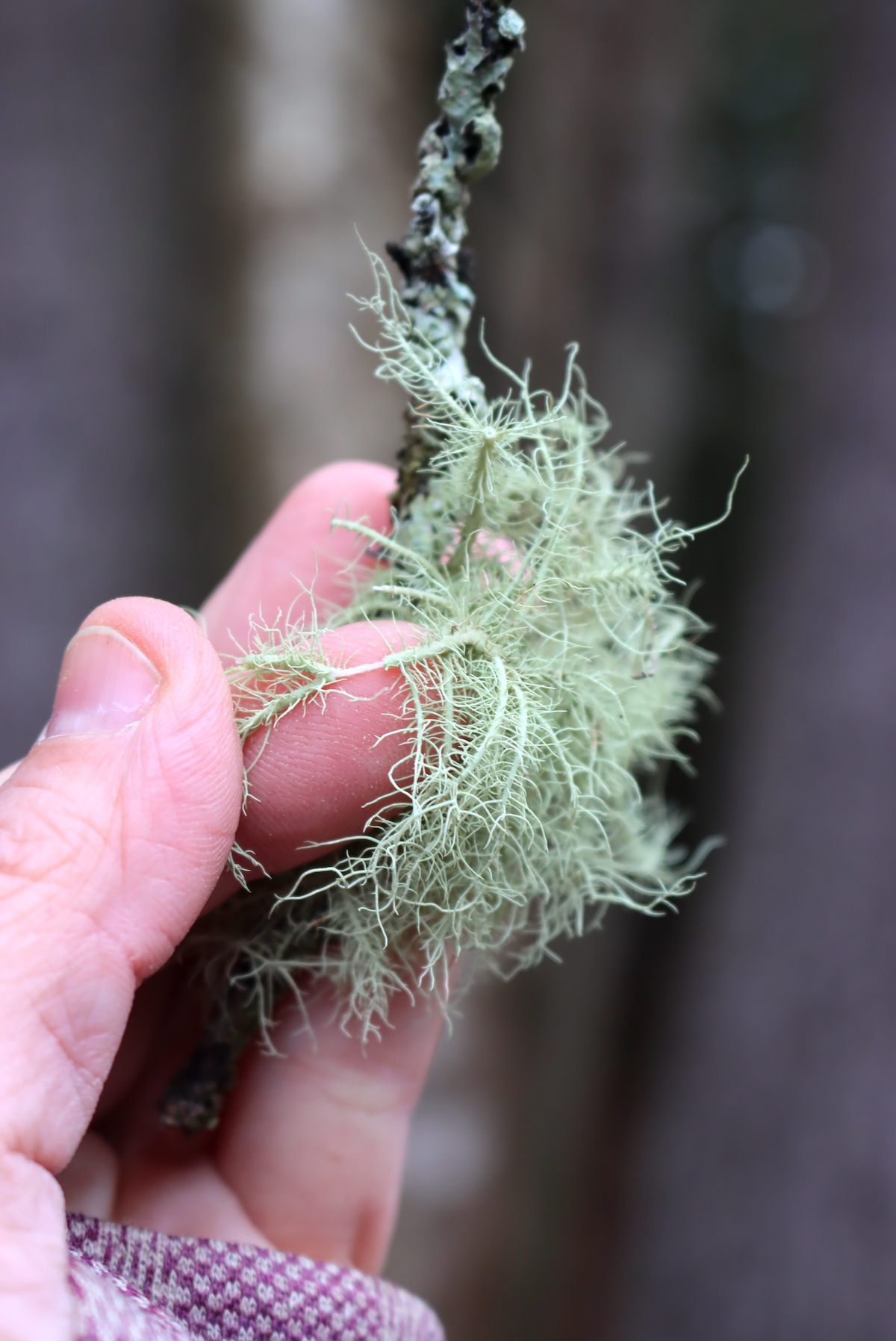
Harvesting Usnea
Usnea is slow-growing, and it’s generally recommended to leave it in place if it’s attached to a tree. It often falls on its own though, especially after wind storms.
In the late winter, we’ll see it all over as the snow melts. It’s fallen throughout the season and then been covered (and preserved) by snowfall.
In summer, violent thunderstorms will also knock it down, so a quick walk through a wooded area after a storm is a great way to find usnea.
If you find it attached to a tree, try coming back to the area after a storm or in the spring after the winter snows melt. In that case, it’s usually easy enough to harvest a bunch that would otherwise just decompose on the forest floor anyway.
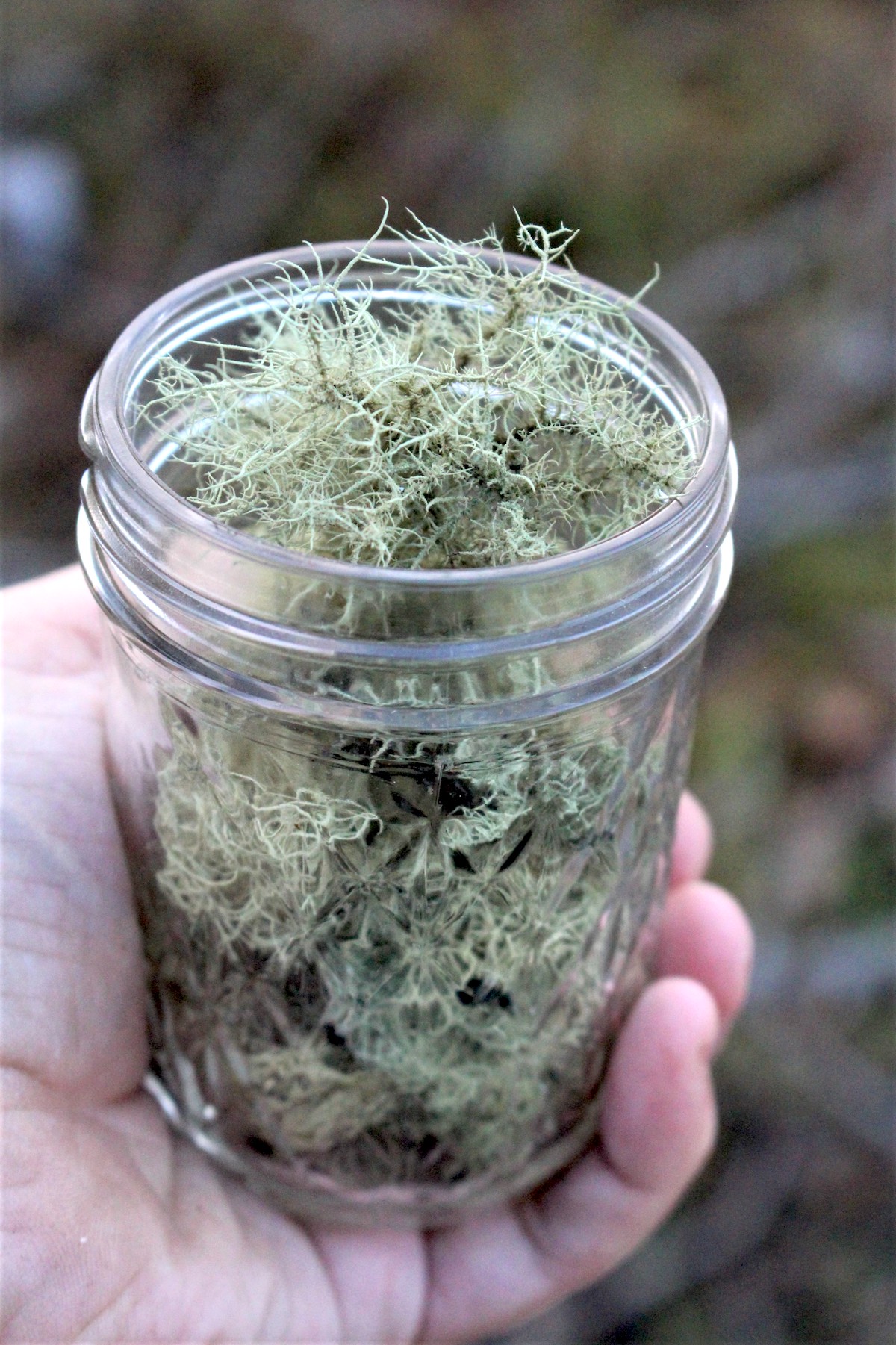
How to Use Usnea
Once detached from the tree, usnea drys out quickly. Drying usnea is a great way to store it, and it’ll do that naturally on its own without much special preparation.
Dried hunks can be applied topically, and it was used historically in that way as a wound dressing.
The more common preparation is usnea tincture or tea, which makes it a bit easier to use. (We don’t generally pack lichen into wounds anymore, but we are willing to spray them with an antibiotic tincture.)
Making a usnea tincture is the same as making any other herbal tincture. Simply pack a jar about 2/3 the way full, and then cover with a neutral spirit (like vodka).

Store it in a dark place for 4 to 6 weeks, shaking occasionally, then strain.
Once strained, tinctures are usually stored in amber dropper bottles for easy application. The dark amber color keeps the medicinal constituents from breaking down in from UV in ambient sunlight.
For topical use, spray bottles work well too.
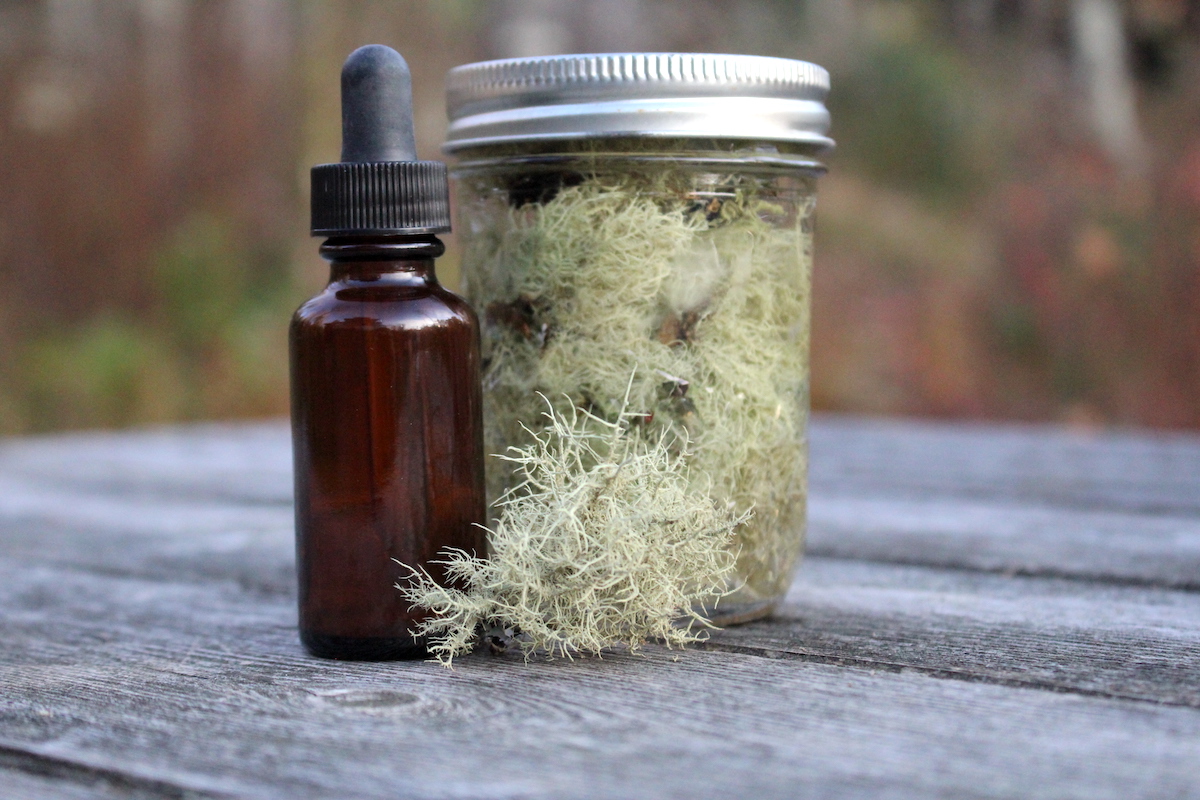
Foraging Guides
Looking for more foraging guides?
- Foraging Serviceberries
- Foraging Chanterelle Mushrooms
- Foraging Morel Mushrooms
- Foraging Partridgeberry
- Foraging Barberry
Foraging Lists
Not sure what to forage next?
- 100+ Edible Wild Plants (A Foragers Bucket List)
- 50+ Edible Wild Berries and Fruits
- 50+ Plants to Forage in Winter
- 40+ Plants You Can Make Into Flour
- 30+ Edible Grains and Seeds
- 20+ Edible Roots and Tubers
- 20+ Plants to Forage in Spring
- 16+ Mushrooms to Forage in Winter
- 13+ Mushrooms for Beginners
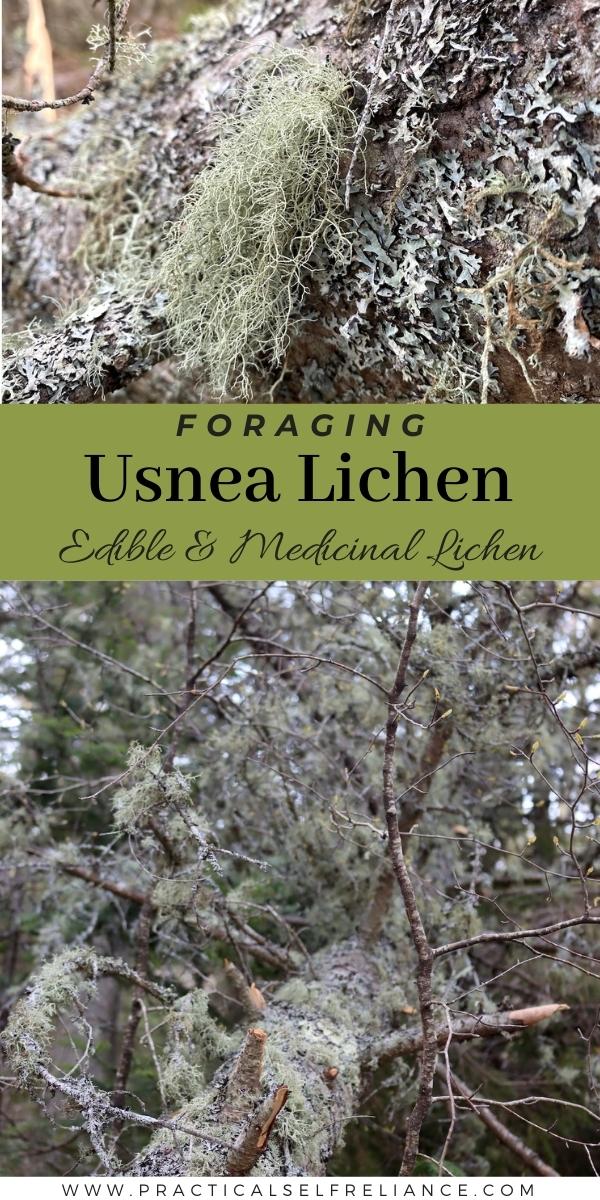




After you harvest what you find on branches and trees, should you “wash” the usnea
before making the tea or tincture ? And do you leave on the tiny attachment at its base or cut it off? Thank you for your nice pictures of this lichen.
I don’t wash it, I just use it as it is, but that’s a matter of personal preference and you can rinse it in cool clean water if you’d like. The nice thing about this one is it really only grows where there’s very clean air and no pollution, so if anything, you’re just cleaning dust but not other environmental nasties (usually). I tend to leave a bit of the tree attachment point on the lichen when I use it because I’m often pulling it off of dead and downed pine, and that bark has complimentary medicinal uses (and is tasty). It can grow on anything though, so if you’re not sure what tree you got it from, it’s best to remove that bit of bark. Enjoy!
Thank you so much for your quick response, Ashley! I really appreciate this information. Mine is also from pine.
You’re quite welcome!
Your information was spot on. I appreciated your multiple ways of identifying usnea. Thank you
Wonderful Mary, so glad it was helpful to you!
I believe the usnea look-a-like is oak moss (Evernia prunastri), another interesting lichen with a long history of use. I’d love to see you do a write up on various lichens and their uses (hint hint). Keep up the great work!
Thanks. We’re glad you’re enjoying the posts.
Thank you for this great article. I am always on the hunt for a new medicine. With goldenseal being over harvested, I am always looking for a new herb with antibiotic properties. I guess I need a hiking trip to the woods. 🙂
You’re very welcome.
Thanks for a great and informative article. I literally have this growing all over my neighborhood and my back yard. I live on Cape Cod, so we have “good airflow”, a.k.a. lots of wind, lol.
You’re very welcome. We’re so glad you enjoyed the post.
Great information thank you, what % of alcohol should the vodka be? Ever clear potency or Stoli potency? Once the tincture is ready, how much can one take and how often, for an illness.
If the usnea is dried then a standard vodka will work. If not you want to use a higher proof such as Everclear.
I’d love to know how to prepare it for oral use??
Usnea is typically prepared as a tincture or tea.
How do you prepare it for oral consumption??
I can only find information on preparing it for external use (Tincture)
It can be used as a tea or a tincture
How long is usnea tincture good (of made with vodka and stored appropriately?
With the high volume of alcohol it should last indefinitely although the effectiveness could possibly decrease over time.
I know you’re not giving medical advice, but is there a resource you would use to determine whether or not somebody is allergic to usnea? I ask because my son is allergic to penicillin, so I’m always on the lookout for alternatives and also ways to keep his immune system up to avoid needing antibiotics if possible. Since penicillins are fungi-related, and lichen are literally part of the fungi family, I’m wanting to cover my bases. Thanks for all your time and energy. I always look forward to your articles!
If you have someone with a known allergy like that it would be a good idea to consult with a clinical herbalist in your area that has experience in this.
I didn’t even know such a thing existed. I”ll look. 🙂 Thanks for the reply!
You’re very welcome.
Hi! I have a son allergic to all three childhood antibiotics (or at least the ones that we used 10 years ago- amoxicillin, z-packs, and keflex? (Or similar to that.) We had great success with colloidal silver. He is 14 now and hasn’t been on regular antibiotics since he was 3. He crouped til 5 years old and had ear infections constantly, so we encountered antibiotics a lot before 3yrs. None since then!
I failed to find an answer to my question.
When there are yellowish bud like structures on what otherwise is identifiably Usnea. IE white elastic core and single stem attachment. Is Usnea bearing those yellowish flower like or bud like structures toxic or is it safe for consumption.?
I have read that it’s best to avoid any lichen that has yellow parts. I would not consume it unless you are 100% sure of the identification.
I make Usnea tincture each year. I’ve never thought of it for the stomach lining. Would you think it would help Barrett’s Esophagus?
If so, I’m curious as to the dosage.
Thank you!
I’m not familiar with Barrett’s Esophagus, but even if I was, I can’t give you any specific medical advice, but best of luck finding the answers you need.
How long does usnea last once it’s dried
It should last for quite a while once it’s dried but just like any herb will slowly loose some of its potency with time.
The description was very useful easy to understand and helpful . You covered everything I needed to know. Thank you
You’re very welcome. We’re so glad you found it helpful.
Was searching web for medicinal herbs and found you. Just subscribed after spending A LOT of time on this site and plan to spend much more. Ty for such a wonderful place to learn and be inspired!
You’re very welcome. We’re so glad you enjoyed it.